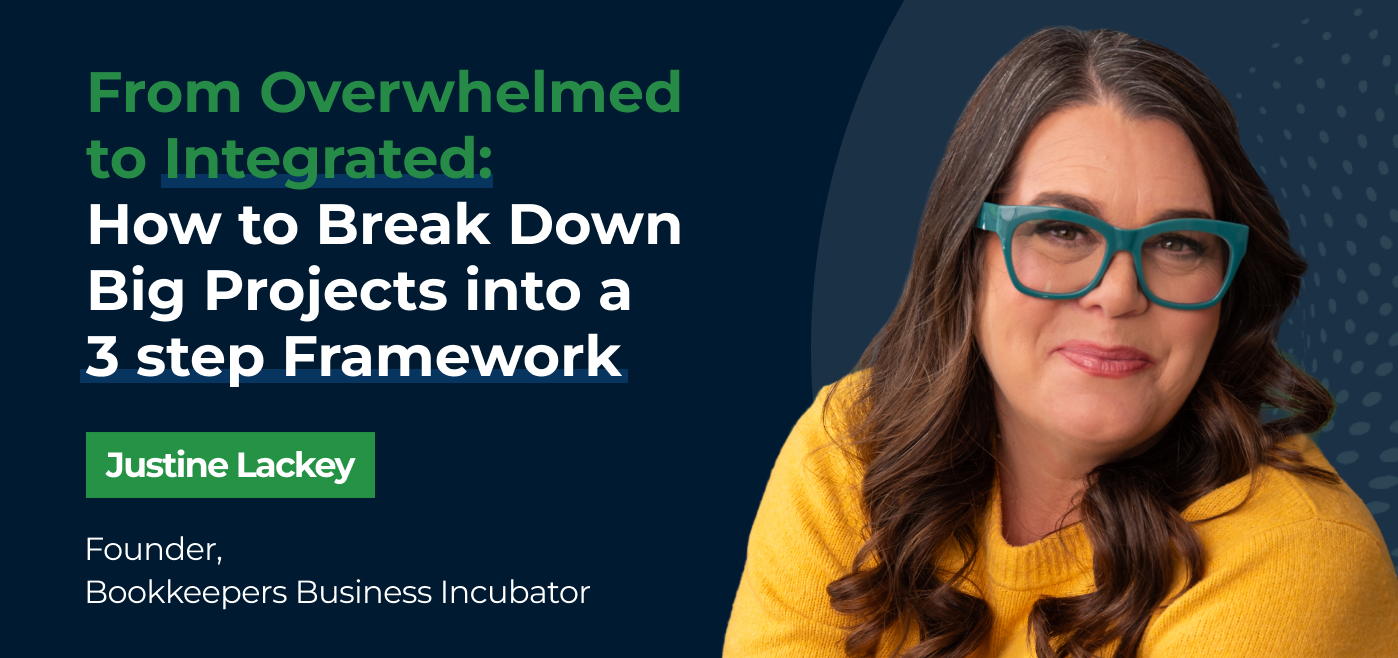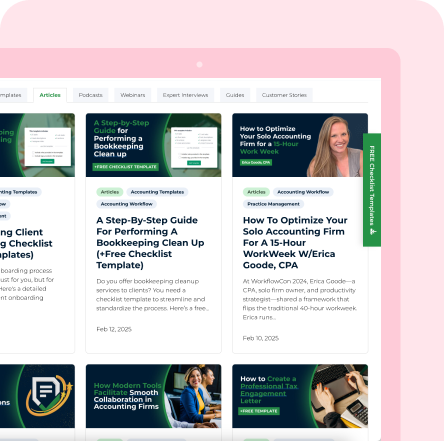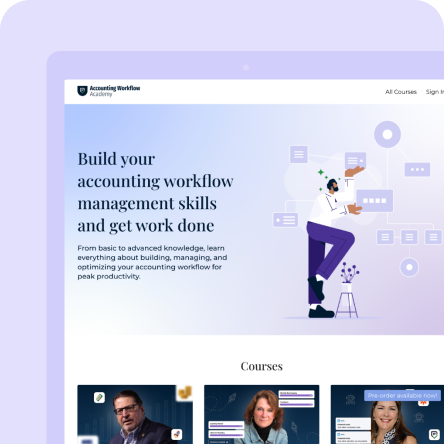For accounting firm owners, the demands of running a business are relentless—tax deadlines, onboarding new clients, keeping current ones satisfied, and managing a team, all while trying to plan for long-term growth.
It often feels like you are racing to put out fires, leaving little time to tackle the big, strategic goals that could truly transform your business.
This exact challenge was the focus of Justine Lackey, founder of the Bookkeepers Business Incubator and a seasoned mentor to accounting professionals, at WorkflowCon 2024, where she introduced her proven 3-step framework for turning overwhelming projects into clear, actionable plans.
“We all want success, but without structure, even the most ambitious goals can feel like quicksand,” Lackey explains. Her solution? A step-by-step method to simplify and conquer your biggest objectives.
In this article, we will break down Lackey’s 3-step framework and show you how to use it to tackle the challenges unique to your accounting firm. Whether you want to revamp your pricing strategy, streamline client onboarding, or scale your operations, this approach will help you turn lofty goals into achievable milestones.
Step 1: Set SMARTER Goals
Imagine you are driving without a map, GPS, or clear destination in mind. You may cover a lot of ground, but how will you know when you have arrived? The same logic applies to goal setting.
Lackey believes that most accounting firm owners fail to achieve their biggest goals because they start with ambiguous statements like, “I want to grow my business” or “I want to make more money.” These goals sound inspiring but lack the precision needed to translate ambition into action.
Ambiguity is where dreams go to die"
Justine LackeyHer answer is the SMARTER framework, which refines vague ideas into structured, actionable goals:
- Specific: Define exactly what you want to achieve.
- Measurable: Use numbers to track progress.
- Actionable: Start each goal with a verb to outline what must be done.
- Relevant: Ensure the goal aligns with your business priorities.
- Time-bound: Set clear deadlines to create urgency.
- Exciting: Choose goals that motivate and inspire action.
- Risky: Push yourself beyond your comfort zone to spark growth.
For instance, instead of setting a vague goal like “grow revenue,” a SMARTER goal might be:
Increase monthly revenue from $15,000 to $30,000 by onboarding five new clients and raising rates by 15% by June 30.”"
This level of specificity eliminates the guesswork. You can now measure progress, stay motivated by the challenge, and take actionable steps to meet a clear deadline.
The simple act of writing your goals creates new neural connections in the brain, making you more likely to achieve them. It moves the goal from abstract to actionable."
Justine Lackey.Step 2: Break Goals into Projects (Create Milestones for Progress)
Once you have a clear goal, the next step is to break it down into smaller, manageable projects.
Let us return to the example of increasing monthly revenue. Here are possible projects to support that goal:
1. Analyze Current Revenue Streams: Before you can grow revenue, you must understand where your income is coming from and where opportunities exist to optimize. This project might include:
- Reviewing current clients and their profitability.
- Identifying services that are underpriced.
- Highlighting gaps in your service offerings that could be filled to attract new clients.
This project lays the foundation for informed decisions about pricing, marketing, and client acquisition. As Lackey explains, “Projects are all about clarity. When you know where you stand, you can plan your next move with confidence.”
2. Develop a Pricing Strategy: Pricing is one of the most critical levers for increasing revenue in an accounting firm, but it is often approached with trepidation.
Key components of this project might include:
- Conducting competitor research to understand standard pricing in your market.
- Identifying value-added services that justify rate increases.
- Creating new pricing packages tailored to different client segments.
Lackey also stresses the importance of communication:
Whenever you increase rates, you must approach it with transparency and professionalism. A project focused on pricing should include crafting client letters or scheduling re-enrollment calls to explain your new structure"
3. Create Marketing Campaigns: With the pricing strategy in place, the next project might focus on finding and onboarding new clients. This is where a marketing campaign becomes critical. A well-executed campaign ensures that you reach your revenue goal by expanding your client base while reinforcing your value proposition to current clients.
Tasks for this project might include:
- Defining your ideal client profile (e.g., small business owners in a specific industry).
- Creating marketing materials, such as emails, social media posts, or blog content, that address client pain points.
- To generate leads, host a webinar or offer free resources, such as an “End-of-Year Tax Checklist. “
Each project is a step on the journey, and each builds momentum toward the ultimate goal.
Why Breaking Goals Into Projects Works
Breaking a goal into projects removes the feeling of being overwhelmed by a large objective. Instead of focusing on the mountain, you focus on the next mile. For accounting firms, this approach is particularly effective when tackling initiatives like improving client onboarding systems or implementing new software tools.
Projects create the structure needed to turn an overwhelming goal into something tangible and achievable."
Justine LackeyWhat to Avoid When Defining Projects
While projects create clarity, they can also lead to confusion if not properly defined. Here are some common mistakes and how to avoid them:
- Projects That Are Too Broad: If a project feels as overwhelming as the goal itself, it is likely too broad. For example, instead of “Improve Client Onboarding,” focus on specific outcomes such as “Redesign the Client Intake Form” or “Automate Contract Signing.”
- Too Many Projects at Once: Avoid overloading your plate with multiple projects. Prioritize two or three key projects at a time to maintain focus and avoid burnout.
- Skipping Dependencies: Some projects must happen in a particular order. For instance, you cannot implement a pricing strategy without first analyzing your revenue streams. Plan your projects sequentially to avoid unnecessary roadblocks.
Step 3: Break Projects into Tasks (The Power of Micro-Steps)
Even when you break your big goals into smaller projects, those projects can still feel overwhelming. For accounting firm owners, a project like “Develop a New Pricing Strategy” or “Streamline Client Onboarding” might seem like a massive mountain to climb. This is where the magic of micro-steps comes in.
Breaking projects into smaller, actionable tasks provides the clarity and momentum needed to move forward
Tasks are the literal steps you take minute by minute or hour by hour to achieve your projects. They transform big, daunting projects into manageable to-do lists."
Justine LackeyHow to Prioritize Tasks for Maximum Impact
Even with tasks broken down, deciding which to tackle first can be a challenge. Lackey offers these tips for prioritizing tasks:
1. Use the “Big Three” Method
Each day, identify your three most critical tasks—the ones that will drive the most progress toward your goals. For example:
- Write the first draft of your pricing strategy letter.
- Set up a meeting to review competitor pricing data.
- Test your automated client onboarding workflow.
Lackey explains:
Focusing on three tasks per day ensures you prioritize progress without spreading yourself too thin"
2. Estimate Time for Each Task
Tasks should be manageable within the time you have available. If a task feels too large, break it down further. For example, instead of “Research all competitors,” focus on “Review pricing for three competitors in the local market.”
3. Use a Timer or Block Scheduling
Many accounting firm owners find success with time-blocking techniques. Allocate specific time slots for focused work on high-priority tasks. For example, dedicate one hour in the morning to client onboarding updates and another in the afternoon to reviewing profitability data.
You may be interested in:
4. Create a Task Hierarchy
Some tasks depend on others. For instance, you cannot write a pricing strategy letter before finalizing your new pricing packages. Identify which tasks must be completed first and group them logically.
Accountability: The Secret to Overcoming Overwhelm
When achieving big goals, even the most structured plans can fall apart without accountability. Lackey emphasizes that accountability is the glue that holds your efforts together. It ensures you stay focused, track progress, and consistently move forward—even when motivation wavers or distractions arise.
Accountability is especially critical for accounting firm owners. With competing demands from clients, team members, and compliance deadlines, it is easy to let long-term goals slip by.
Accountability is the antidote to overwhelm. It gives you the structure and support to stick to your goals, even when life gets busy."
Justine LackeyHow to Leverage External Support With Community Accountability
Here are some ways to incorporate community accountability into your workflow:
1. Join a Mastermind Group
Mastermind groups bring together like-minded professionals to share goals, challenges, and solutions. These groups often meet regularly, providing a structured environment for accountability. For accounting firm owners, a mastermind group can be an invaluable resource for advice on industry-specific issues, such as pricing strategies or client retention.
You may be interested in:
2. Partner With a Business Accountability Buddy
An accountability buddy is someone who shares your commitment to growth and success. Schedule weekly or biweekly check-ins to discuss progress, celebrate wins, and troubleshoot roadblocks.
For instance, you might partner with another accounting professional who is also working on scaling their business. Sharing insights and holding each other accountable can create a mutually beneficial relationship.
3. Engage Your Team
If you have a team, they can play a crucial role in holding you accountable. For example:
- Share your quarterly goals during team meetings.
- Delegate specific tasks and set deadlines for follow-ups.
- Ask team members to provide feedback on progress and suggest improvements.
Engaging your team not only keeps you accountable but also fosters a culture of collaboration and shared responsibility.
Turn Insights into Actions in Your Accounting Firm
Big goals can feel intimidating, especially for accounting firm owners who are juggling client deadlines, team management, and the daily grind of running a business. But as Justine Lackey said, success does not come from trying to tackle everything all at once. It comes from having a structured plan, taking consistent action, and holding yourself accountable every step of the way.
Lackey’s three-step framework—setting SMARTER goals, breaking them into projects, and then dividing projects into actionable tasks—is more than just a method. It is a mindset shift. It transforms how you approach your goals, moving you from a reactive, overwhelmed state to one of clarity and control.
Also, a tool like Financial Cents can help you achieve your firm goals. With features designed specifically for accounting firms, Financial Cents makes it easier to manage your projects and workflow so you can focus on important work instead of getting stuck in admin tasks.






